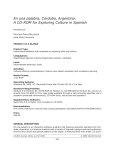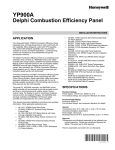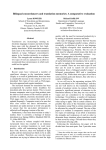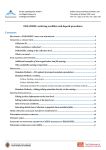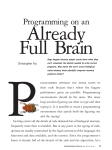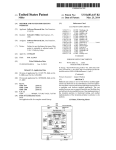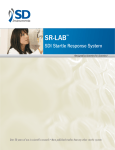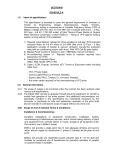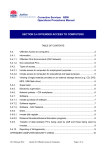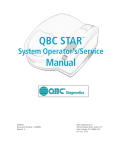Download Issues in English
Transcript
CALICO Journal, 25 (1) Software Review Issues in English Reviewed by JILL TURNBULL Monash University PRODUCT AT A GLANCE Product Type: Multimedia language learning software Language: ESL Level: Beginning to Advanced Activity: Self-directed activities, tutorial information and exercises based on video clips and written text designed to develop the language skills of reading, writing, spelling, listening, grammar, vocabulary, and pronunciation Media Format: 1 CD-ROM Operating Systems: Windows 3.1 or higher including Windows NT Hardware Requirements: PC 486-66+; 8 MB RAM; 18 MB of hard disk space; 256 color video display; 2x CD-ROM drive; sound card (preferably not on-board type); speakers or headphones; microphone Price: Individual copy $160 AUS (~ $105 US); license + CD: five computers $320 AUS (~$210 US), 10 computers $480 AUS (~$315 US); site license: 1 physical location $640 AUS (~$415 US) GENERAL DESCRIPTION The Issues in English program is an interactive learning program designed for self-access. It includes activities and exercises related to eight topical issues: animal rights, discrimination, euthanasia, gambling, growing old, public transport, smoking, and the environment. Each issue is presented in video clips at four different levels of language difficulty from beginning to advanced. The levels of difficulty are advertised as being suited to ASLPR, CGEA, and NRS Levels 1 to 4.1 The discourse type at Levels 1 to 3 is informal and personal spoken English. At Level 4, the emphasis is on the more formal spoken discourse of public speaking. CALICO Journal, 25 (1), p-p 147-156. © 2007 CALICO Journal 147 CALICO Journal, 25 (1) Software Review The greatest strength of the program is the language teaching methodology adopted. De Fazio (1997, p. 62) and Dell’Orefice (1998, p. 18) also comment on its “salient pedagogical aspects” and the “sound adult learning principles,” respectively, in their reviews of this program. A discussion of the language teaching approach taken by the author of the program is included in the latter part of this review. The Manual A 23-page A5 size user manual for Issues in English includes clear instructions for installing and using the program on a stand-alone computer or a network, information about specific features and the exercises contained in the program, guidelines for its use, and student record sheets for photocopying. The manual also includes a 1-page troubleshooting guide for users experiencing technical difficulties. Contextualized online help for using navigation icons is available at all times (written and spoken) by clicking on a help icon. EVALUATION Speed, Reliability, and Compatibility The program was trialed on different computers each with a Pentium processor but with different operating systems: Windows 95, 98, and NT. The program speed and reliability were found to be generally good. The main problem we have experienced in running the program is hardware related. With on-board sound cards, rather than stand-alone types installed in our lab computers, the sound quality of a user’s own recorded pronunciation in the speaking activities is very poor. User Interface, Screen Management, and Navigation The Issues in English interface is user friendly in its simplicity of design, although it is not entirely intuitive (see Figure 1). While an online help function is provided, it is limited to providing information about the use of the icons in the interface and is a little awkward to use at first. It is easy to forget that the help feature is turned on and to get trapped in a ‘help maze.’ Whereas adequate information about icon functions, possible learning paths, and learning strategies are provided in the printed manual, this information is not provided online. Many first-time users of the program could benefit from access to this type of online help (Hoven, 1999). The video screen (see Figure 2) provides quite intuitive icons for controlling the video, and the speaking activity screen also has easy to understand icons for controlling listening and recording functions. One constraint is that the rewind button for the video will always return learners to the start of the video. Only with text displayed can learners move to different sections of the text. 148 CALICO Journal, 25 (1) Software Review Figure 1 Program Interface Figure 2 Video Screen 149 CALICO Journal, 25 (1) Software Review Easy access to the printing facility is available on each video and exercise screen. The printer lock is a useful feature for controlling access, though its presence on the Main Menu may be a little confusing for students. Locking the printer helps to avoid its overuse; if left unlocked, one click on the icon launches a printout of the current screen’s contents. The requirement to enter a password before printing acts as a check on users’ intent to print. Exploitation of Computer Potential The computer’s potential to provide an interactive multimedia learning program is well demonstrated in Issues in English. Audio and text alternatives are provided for the transcripts, the help, and some of the exercises and feedback. Graphics are used to convey language meaning in some of the transcripts and exercises at the lower levels. Hypertext is used to great advantage in video transcripts and in the writing and grammar sections, with hot words being linked to explanations of meaning or examples of language use. Although multimedia is used effectively in many ways to facilitate learning, the computer’s capability for presenting audio/visual material has not been fully exploited in this program. Each issue is presented in a video clip, with a person speaking directly into the camera, as if addressing an imaginary listener (i.e., the learner). While this use of video does not exploit the media’s full potential for delivering complementary visual and auditory cues in authentic contexts (see Hoven, 1999), the author of the program has intentionally used improvised contexts so that the “user feels that the speaker is speaking to them.” This simple approach is quite effective but would perhaps seem more convincing with a less awkward and stilted delivery of the ‘talking heads.’ Activities (Procedures) Information about the range of language skills covered at each of the four levels and the associated exercises is provided in the section called Teaching Points, which is accessible from the Main Menu, as are the video clips of the eight topical issues. To begin using the program, learners select a level of difficulty and then an issue to explore. This launches a video screen with video controls for playing, pausing, or rewinding the video. There are options to listen with or without the transcript visible; and when the text is visible, it is possible to listen to individual sentences by clicking on the text with the mouse. There is also a facility for clicking on hot words in the text for an explanation of meaning. The video screen controls and the hypertext links facilitate a focus on language in context and meaningful communicative interaction between the learner and the computer. When ready to continue, learners select from a list of exercise types, which are based on the video content. These follow-up exercises provide opportunities for focusing more intensively on, and extending, the language presented in context. The exercises are presented within the framework of the specific macro and micro language skills found in the Teaching Points menu. The Getting Started section of each issue and level presents comprehension questions, cloze, spelling, and dictation activities. The Listening section contains exercises at Levels 1 and 2. These require learners to match spoken words or sentences with written text or pictures. Matching exercises are also used in the Vocabulary section at Levels 1 and 2 for similar and opposite meanings. The Vocabulary section at Levels 3 and 4 introduces additional activities involving writing definitions for words. 150 CALICO Journal, 25 (1) Software Review In the Speaking section of each topic and level, learners can record their own voice and compare their pronunciation of words from the spoken text with that of a native English speaker. The pronunciation activities provide meaningful language practice to the extent that the words and sentences included in the practice activities are extracted from or based on the language from the video clips. While this approach is a pedagogically appropriate use of context-based language, it is unfortunate that opportunities are not provided for learners to practice and compare their pronunciation of larger sections of the continuous speech from the video clips. Such interaction can enhance awareness of the prosodic features of natural and continuous speech—accent, intonation, and rhythm (Hoven, 1999). The Grammar section adopts a ‘structural’ approach to the organization of grammatical structures across the four levels, that is, it sequences them according to a particular view of the levels of grammatical difficulty. Exercise types include multiple choice, fill in the gap, or complete the sentence. Mostly, these involve transformation of a given grammatical structure for which feedback is provided. Tutorial information is available to support the activities. The Writing section of the program includes activities and exercises on punctuation, comprehension, and expressing opinion at each of the four levels (see Figure 3). In addition, Levels 3 and 4 introduce the steps involved in summary writing. Apart from punctuation which is a multiple-choice type of exercise at Levels 1 to 3, all other Writing activities involve open written responses which require teacher feedback. Figure 3 Expressing Opinion The writing activities are well structured and appropriately scaffolded from level to level, with tutorial support provided for the Punctuation, What Do You Think?, and Summary 151 CALICO Journal, 25 (1) Software Review Writing activities. However, there are a number of problems relating to response handling and feedback which could have been avoided, to some extent, by providing additional instructions and information at various points in the activities. First, the open-ended written exercises require teacher feedback, but the program does not notify the learner of this. Thus, students tend to become confused when the computer does not provide feedback. Second, the open-ended exercises often do not include a clear instruction notifying learners of the option to use pen and paper. Learners who find typing in text boxes slow and tedious may not be aware that the handwritten approach is an option—they may, after all, be expecting feedback from the computer. Third, a more significant problem presents itself if learners wish to refer back to a video clip to complete a task because the video clip is located on a different screen from the response box. This occurs with summary writing activities at Level 3, in which the task is to identify and record the main ideas. Learners who attempt to respond to the task on-screen, rather than on paper, are faced with the additional cognitive load of retaining information while moving between screens. At Level 4, the same type of activity works well, as the video clip appears on the same page as the response box for recording main ideas. After completing the main ideas exercise, it is intended that learners will print the response (if pen and paper is not used) for reference in the following summary writing exercise. If learners do not print a response, however, before moving to the summary exercise, the response is lost. This could be easily avoided with the inclusion of more explicit instructions regarding the use of pen and paper and the printer. A similar problem occurs in the vocabulary exercises on same and opposite meanings at Level 4. Once again, the preferred approach in this activity is that learners will print the text rather than switch backwards and forwards between screens to consult the video transcript. The program comprises a number of other useful features to complement the learning activities described above. These include feedback options of instant or delayed feedback and the provision for printing tutorial information, transcripts, worksheets, answer sheets, and completed activities. Teacher Fit (Approach) CALL methodology and language acquisition theory The Issues in English program combines a variety of facilitative, interactive, and instructional CALL methodologies which reflect elements of acquisition, explicit, and behaviorist second language acquisition theories. (see Hubbard, 1988 for a discussion of these theories). In using an interactive CALL methodology, the program is able to partially compensate for an absence of interpersonal interaction. The design of the program facilitates a communicative style of learner interaction with the computer and negotiation of meaning through a variety of media including print, audio, visual, and audio-visual. The inclusion of contextualized tutorial information for various teaching points, immediate feedback on most tasks, and learner control over learning paths and strategies set the scene for active participation in learning. However, the program would be more instructive if learners were more informed (online) of the choices available to them in learning paths and strategies (Hoven, 1999). In the program, an instructional teaching methodology supplements the communicative approach of learning language in context. A variety of practice activities provide opportunities for learners to analyze and synthesize their communicative experience of the language. 152 CALICO Journal, 25 (1) Software Review This reflects the preferred current CALL strategy (Laurillard & Marullo 1993, p. 147), whereby “once learners have absorbed some chunks of language and patterns of communication, they should be given access to the underlying model via a guided discovery approach that uses both learner-controlled exploration and teacher-controlled demonstration.” Linguistic theory and linguistic accuracy De Fazio (1997) notes the ambitious nature of Issues in English in the diversity of its material and in the levels of proficiency it addresses. It is perhaps also overly ambitious in attempting to incorporate instruction about writing conventions, when the only models used are transcripts of spoken language. Since there is no discussion within the program of the differences between spoken and written modes of language (e.g., functions, forms, and linguistic characteristics) or more specifically the differences linked to levels of formality that exist between personal and academic writing, this could lead learners to false notions about the nature of writing (see Leech, Deuchar & Hoogenraad, 1993, for a discussion of these differences). Certain vocabulary and grammatical constructions, though normally avoided in formal writing contexts, are acceptable in speech and personal forms of writing. For example, even in the Gambling Level 4 transcript (the most formal level of spoken language in the program), informal language such as contractions (e.g., “there’s” and “can’t”) and other expressions (e.g., “So I guess” and “guesstimate”) are used. At Level 3, the language is less formal (e.g., “Well; Anyway, to cut a long story short” and “Oh, it wasn’t too bad”). While the program does provide meanings for some of the informal expressions, it would perhaps also have been useful to include comments on language use, that is, information about levels of formality and the appropriateness or otherwise of using informal expressions in written texts. In the Grammar section of the Gambling Level 4 issue, the rules for transforming direct speech into reported speech are prescriptive rather than descriptive and, therefore, most relevant in formal writing contexts. Referring to the transformation of the example “She didn’t want to,” it is difficult to imagine a formal context for reporting Andrew said that his wife had not wanted to. Arguably, such information is more likely to appear in an informal written context, perhaps a letter, and would be written as it might be spoken, that is, “Andrew said that his wife didn’t want to.” The exercises in the program do not provide a formal context, yet responses which use informal language are judged as incorrect. Punctuation is also a fuzzy area if applied to spoken texts because it presumes that we speak in full and linguistically complete sentences. The Gambling Level 4 transcript, for instance, is characterized by long sentences that make much use of commas but are not always linguistically accurate. Sociolinguistic accuracy With the inclusion of a mix of 14 speakers from different age groups and ethnic backgrounds, the program conveys an authentic sense of the multicultural flavor of Australian society and a variety of English accents. None of the speakers has a very broad Australian accent, but there is a good deal of variation evident. The themes of the video clips are not culturally specific and would thus be of interest to students across the globe. The content is both informative and comparative of the Australian and international contexts. A more distinctive Australian flavor emerges by way of the language used in some of the more conversational clips, for example, ‘chooks’ (chickens) and ‘pub’ (bar). 153 CALICO Journal, 25 (1) Software Review Learner Fit (Design) The Issues in English program gives learners choice of content, level, task type, sequence, learning approach, and pace and thus gives learners greater control over their own learning to accommodate individual needs. Learners are also given the option to read video transcripts while listening, if this is their preferred learning strategy. While learners may find this a useful feature, it is possible that they are not always the best judges of the most effective strategies to use when such options are given. Wakabayashi and Morishita (1993), in an evaluation of an interactive listening comprehension program, suggest that help mechanisms of this kind may be counterproductive for some visually trained learners who may be inclined to “try to comprehend the audio inputs by substituting reading for listening.” To encourage learners to listen first, before reading the text in the video activities, the author has built into the design of the program a no-text option as the default. However, for learners who are inclined to substitute reading comprehension for listening comprehension, more explicit guidance in appropriate strategies is likely to be required. Learners will benefit most from this program working in Learn Mode rather than Test Mode. In Learn Mode, feedback after each response rather than at the end of an exercise enables further attempts at a correct answer. The program attempts to compensate for the lack of interpersonal feedback by responding to answers with encouraging expressions such as “Excellent,” or “No” with a rising intonation to encourage another try. It is possible to browse questions before attempting them and to skip questions or exit the activity at any time. What is not provided is a give-up feature to enable quick reference to a correct answer for learners who do not know and do not want to guess the correct answer. In the oppositemeaning activity in the Vocabulary section, for example, students are required to make three attempts before a clue (the next letter in the word) is provided. This requirement removes control from the learners, locking them into a tedious path of negative feedback as they work their way closer and closer toward the correct answer. Also not built into the program is flexible anticipated response handling, “arguably the most important aspect of tutorial CALL” (Burston, 1989, p. 75). Predetermined feedback is limited to an indication of correctness or incorrectness—there are no contextualized explanations linked to the correct and incorrect answers. Explanatory information on teaching points is available in a separate information section but is decontextualized and could easily be overlooked. Linguistic level A comparison of the discourse functions, associated language and text length of the Level 3 and Level 4 texts indicates quite a leap between text levels of difficulty. If we look at the four levels of the issue Gambling, the discourse function at each level could be described as follows: Level 1, narration of a recent personal experience; Level 2, reflection on personal experience and expression of an opinion; Level 3, narration of past and recent personal experience; and Level 4, presentation of information and evaluation of issues. This reviewer is therefore inclined to agree with De Fazio’s comment (1997, p. 62) in relation to text difficulty, that “the scaffolding process from level to level may not be entirely robust.” 154 CALICO Journal, 25 (1) Software Review SUMMARY The Issues in English program exploits the interactive potential of multimedia to present a wide variety of interesting and pedagogically sound language activities designed for self-study and suitable for a range of proficiency levels. The reviewer’s observation is that students enjoy using the program but from time to time experience problems, many of which could easily be overcome with more extensive online help. With attention directed to improving online help, feedback options, and use of video, and with the provision of additional commentary on formal versus informal language use, Issues in English, Mark II (apparently in the pipeline) is bound to be another popular and successful CALL application. SCALED RATING (1 low - 5 high) Implementation Possibilities: 4 Pedagogical Features: 3.5 Sociolinguistic Accuracy : 4 Use of Computer Capabilities: 3 Ease of Use: 3 Overall Evaluation: 3.5 Value for Money: 5 NOTE 1 The Australian Second Language Proficiency Ratings (ASLPR), Certificate of General English for Adults (CGEA) and National Reporting System (NRS) are recognized standards in Australia for measuring English language proficiency. REFERENCES Burston, J. (1989). Towards better tutorial CALL: A matter of intelligent control. CALICO Journal, 6 (4), 75-89. De Fazio, T. (1997). [Review of Issues in English]. ON-CALL, 11 (2), 62-65. Dell’Orefice, Angela. (1998). [Review of Issues in English]. Australian Language Matters, 6 (1). Hoven, D. (1999). A model for listening and viewing comprehension in multimedia environments. Language Learning & Technology, 3 (1), 88-103. Retrieved May 16, 2007, from http://llt.msu. edu/vol3num1/hoven/index.html Hubbard, P. (1988). Language teaching approaches: The evaluation of CALL software and design implications. In W. Smith (Ed.), Modern media in foreign language education: Theory and implementation (pp. 227-254). Lincolnwood, IL: National Textbook Company. Laurillard, D., & Marullo, G. (1993). Computer-based approaches to second language learning. In P. Scrimshaw (Ed.), Language, classrooms and computers (pp. 145-165). 155 CALICO Journal, 25 (1) Software Review Leech, G., Deuchar, M., & Hoogenraad, R. (1982). English grammar for today: A new introduction. London: McMillan. Wakabayashi, S., & Morishita, J.-Y. (1994). The implications for different types of help in listening comprehension with the assistance of a personal computer. In Conference Proceedings: 19th Congress of Applied Linguistics Association of Australia, University of Melbourne. PRODUCER’S CONTACT INFORMATION Designed, produced and published by Protea Textware P.O. Box 49 Hurstbridge Victoria 3099 Australia Phone: +61 3 9714 8660 Fax: +61 3 9714 8644 Email: [email protected] Web: http://www.proteatextware.com.au REVIEWER’S BIODATA Jill Turnbull is a lecturer with the Language and Learning Services Unit at Monash University. She coordinates CALL activities in the Unit’s computer writing lab and is also currently involved in a research project for developing online academic skills and language learning materials. Her teaching background is in ESL, EAP, and Adult Literacy. In addition to web-based learning, her CALL research interests include applications for concordancing in language learning. REVIEWER’S CONTACT INFORMATION Language and Learning Services Unit Monash University Clayton Victoria 3168 AUSTRALIA Phone: 61 3 9905 4026 Fax: 61 3 9905 3060 Email: [email protected] 156










